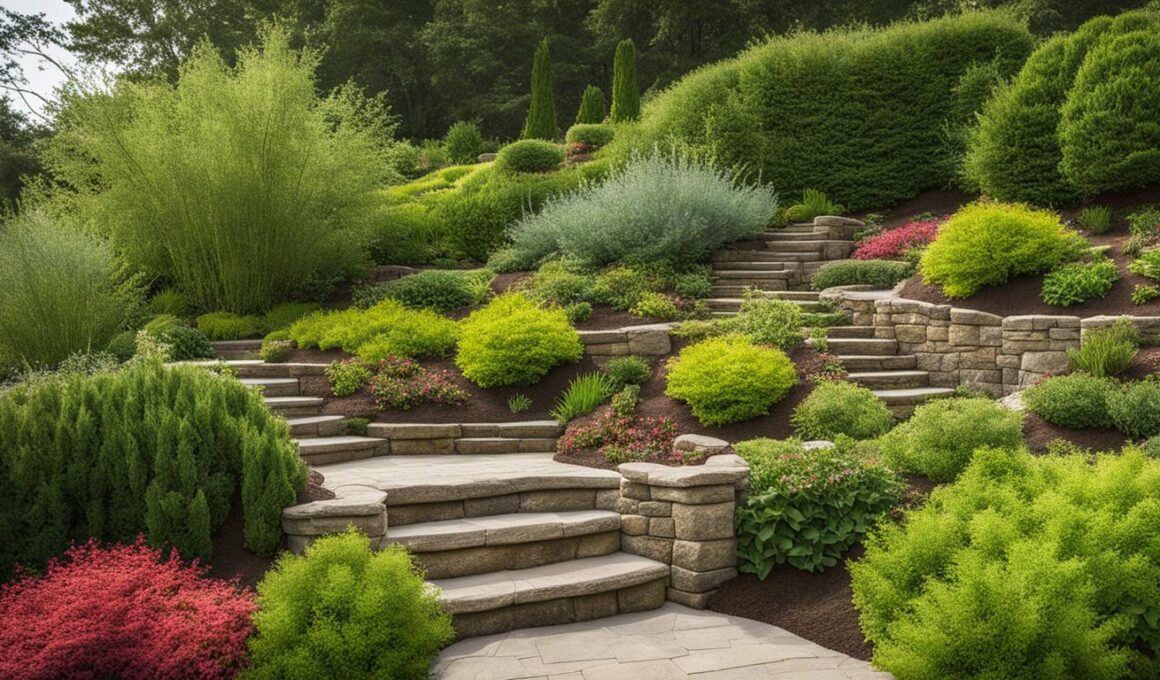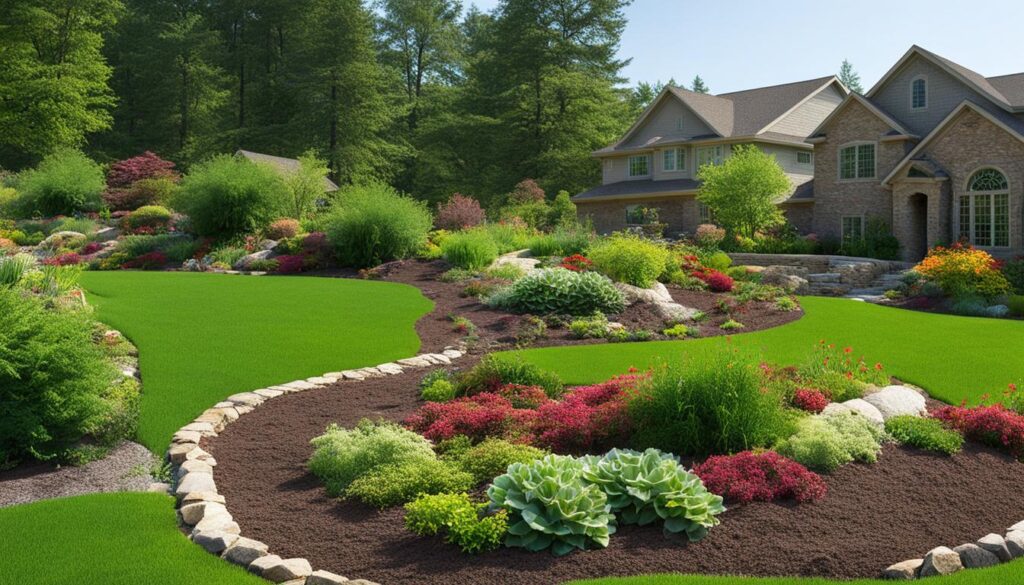Are you concerned about soil erosion and its impact on your outdoor space? Implementing strategic erosion control landscaping techniques can help prevent soil loss, enhance stability, and preserve the beauty of your landscape. Understanding the causes and locations of erosion is crucial for effective erosion control. Factors such as poor drainage, lack of natural binding materials, and the overall makeup of your landscape can contribute to soil erosion.
By examining areas with poor drainage and implementing the use of a rain garden, you can protect the soil by allowing it to absorb water slowly. Selecting water-friendly plants and using mulch to protect the soil’s surface area are other effective methods for preventing soil erosion. These practices not only help retain moisture in the soil but also reduce stormwater runoff, preventing sediment from being carried away.
When it comes to erosion control landscaping, it’s important to implement key strategies such as planting native plants with deep root systems that stabilize the soil and slow down rainwater runoff. Growing grass in non-vegetative areas and installing a drip irrigation system can also prevent erosion by delivering water directly to the roots without overwatering.
Other techniques for erosion control landscaping include creating swales to distribute runoff, using downspout extensions to redirect water flow, and building dry creek beds with rocks and plants to slow down rainwater runoff. French drains with perforated pipes buried under gravel can also redirect runoff to suitable areas.
In order to effectively prevent soil erosion, it’s crucial to avoid compact soil, as it contributes significantly to erosion. By redirecting foot traffic, using lightweight lawn equipment, and aerating the soil, you can minimize soil compaction and reduce erosion risk.
In conclusion, proper erosion control landscaping techniques are essential for preventing soil loss, enhancing stability, and maintaining the beauty of your property. By implementing a combination of strategies, such as rain gardens, native plantings, and mulching, you can effectively protect your soil and contribute to a healthy environment. So, take proactive measures to prevent soil erosion and enjoy a beautiful and resilient landscape.
Key Strategies for Erosion Control Landscaping
When it comes to preventing soil loss in your landscaping, there are several key strategies and methods you can implement. These techniques will not only help maintain the stability of your soil but also contribute to the overall beauty of your outdoor space.
One effective strategy is planting native plants. Native plants have deep root systems that act as natural anchors, stabilizing the soil and slowing down rainwater runoff. By incorporating these plants into your landscape, you can significantly reduce the risk of erosion.
Growing grass in non-vegetative areas is another method to control erosion. Whether you choose to use sod, seed, or hydroseed, a healthy grass cover helps preserve the integrity of the soil. The grass acts as a protective barrier, preventing rainwater from washing away the topsoil.
Installing a drip irrigation system is also a valuable technique for erosion control. This system delivers water directly to the root system, ensuring that plants receive the necessary moisture without overwatering the soil. By minimizing surface runoff, you can effectively prevent soil erosion.
Another viable option is terrace gardening. This method involves creating multiple levels or terraces in your garden and strategically planting vegetation on each level. The terraces act as barriers, slowing down the flow of water and helping to retain more moisture in the soil.
In addition to these strategies, building retaining walls and using riprap can serve as effective erosion control measures. Retaining walls provide structural support and prevent slopes from collapsing, while riprap (loose stones or concrete) can help dissipate the force of rainwater runoff, further preserving the integrity of the soil.
Implementing these erosion control methods in your landscaping not only safeguards your property from soil erosion but also contributes to the overall health and beauty of your outdoor space. By incorporating native plants, growing grass, using drip irrigation, and considering terrace gardening and retaining walls, you can create a landscape that is not only visually appealing but also built to withstand erosion. Take the necessary steps to protect your soil today and enjoy a beautiful and sustainable outdoor environment.
Additional Techniques for Erosion Control Landscaping
In addition to the key strategies mentioned earlier, there are several other techniques that can be employed for erosion control landscaping. These techniques include:
Swale
A swale is a shallow depression that helps distribute runoff and move it to a new location. By directing the flow of water, swales can prevent soil erosion and protect vulnerable areas of your landscape. Consider creating a swale in areas where water tends to collect or runoff occurs.
Downspout Extensions
Downspout extensions are an effective way to redirect water flow away from your foundation. By extending the downspouts away from your home, you can prevent excess water from causing soil erosion around the foundation. Make sure the extensions are properly installed to ensure water is directed safely away from your property.
Dry Creek Beds
Building dry creek beds with rocks and surrounding them with plants can serve as both a functional and decorative element in your landscape design. Dry creek beds help slow down rainwater runoff and provide a natural pathway for water to follow. By creating a visually appealing dry creek bed, you can effectively manage excess water and protect your soil from erosion.
French Drain
A French drain is a trench filled with perforated pipes buried underneath rock or gravel. This drainage system helps redirect excess water to suitable areas, preventing soil erosion and water accumulation. Consider installing a French drain in areas where water tends to pool or flow excessively, ensuring proper water management in your landscape.
Avoid Compact Soil
Compact soil significantly contributes to soil erosion. To avoid this issue, implement methods to prevent soil compaction. Redirect foot traffic away from susceptible areas, use lightweight lawn equipment, and regularly aerate the soil to improve its structure and drainage capabilities.
By incorporating these additional techniques into your erosion control landscaping plan, you can effectively safeguard your property from soil erosion and maintain a stable and beautiful landscape.
How Can Erosion Control Landscaping Help Reduce the Need for Buying Topsoil?
Erosion control landscaping plays a vital role in reducing the yard of topsoil cost by preventing soil loss. Planting trees, shrubs, and groundcovers can help stabilize the soil, while retaining walls and terraces can prevent erosion. This in turn reduces the need for purchasing additional topsoil to replace what has been lost.
Conclusion
Soil erosion is a significant concern that can adversely affect plant growth and water quality in your landscape. To combat this issue, implementing erosion control techniques is crucial. By employing these techniques, you can prevent soil loss and minimize the negative impact of erosion on the surrounding environment.
One effective method is to maintain a healthy, perennial plant cover in your landscape. These plants have robust root systems that stabilize the soil and prevent erosion. Additionally, using mulch helps protect the soil’s surface from the impact of rainwater and enhances its water-holding capacity.
Planting cover crops is another valuable measure to reduce soil erosion. These crops not only provide temporary coverage and protection but also help improve soil structure and nutrient content. Addressing problem areas with specific erosion control methods, such as rain gardens and retaining walls, can provide long-term stability and prevent erosion in vulnerable spots.
By combining these erosion control techniques in your landscaping approach, you can safeguard your property from soil erosion and enjoy the benefits of increased stability and enhanced beauty. Protecting your soil from erosion contributes to a healthier environment and promotes sustainable landscaping practices.











